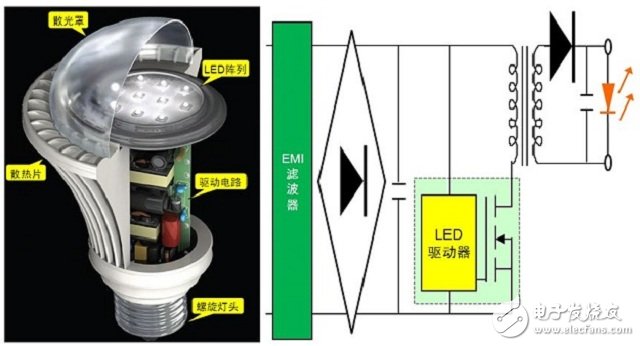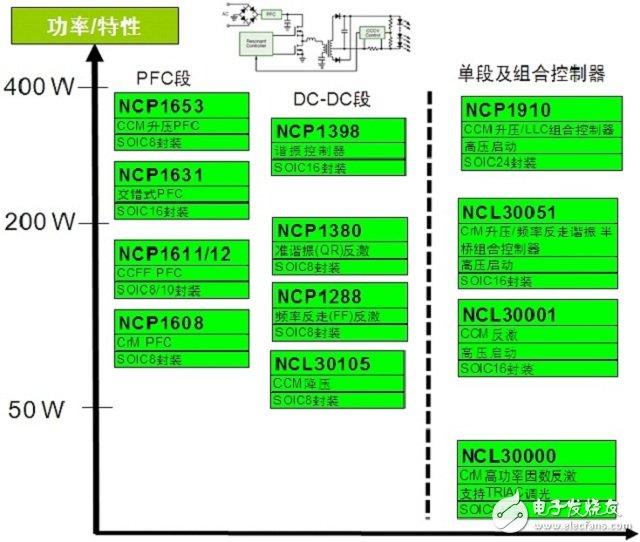Lighting electricity is an important source of global energy consumption. It is estimated that China's lighting electricity consumption accounts for about 12% of the entire society's electricity consumption. Among the various lighting fixtures, incandescent lamps with a long history but low energy efficiency are still widely used. If the use of low energy efficiency light sources is restricted, and more energy efficient and environmentally friendly light sources are vigorously promoted and applied, it will be conducive to energy saving.
Therefore, including China, many countries in the world formulate policies to phase out incandescent bulbs. For example, China plans to eliminate all incandescent bulbs for general lighting above 60W in 2015. Fluorescent lamps and compact fluorescent lamps (CFL) have higher energy efficiency than incandescent lamps and have been used in the market for many years. But fluorescent lamps contain the highly toxic substance mercury, which has caused more and more environmental concerns.
In comparison, the performance of LEDs in various aspects such as luminous efficiency has been continuously improved, and it also has environmental protection and long life characteristics, and is receiving more and more attention. In fact, LED downlights and retrofit bulbs already have higher energy efficiency than current lighting technologies such as incandescent, halogen or CFL. In terms of cost, the study found that compared with 2010, the price of LED has accelerated to decline (a 13% to 24% annual decline), is expected to continue to decline in the next few years, will help reduce the cost of LED bulbs and lamps.
Therefore, countries around the world are optimistic about and promote the development of LED lighting industry. For example, the National Development and Reform Commission of China issued the "Semiconductor Lighting Energy Conservation Industry Plan", which plans to have a market share of LED functional lighting products of more than 20% by 2015, and the annual output value of the LED lighting energy-saving industry will increase by about 30%. Yuan (US $ 72 billion).
LED general lighting applications and development prospects
In addition to being widely used in mobile devices, large and medium-sized Liquid Crystal Display (LCD) backlights, and LED signs, LEDs are also increasingly used in LED car interior / exterior lighting, such as headlights, fog lights, and tail lights. , Parking lights, instrument panel backlighting, roof lights, reading lights and atmosphere lights, as well as LED general lighting such as residential lighting and building decorative lighting.
LED general lighting applications cover a wide range of power, LED residential lighting as low as 3W to 15W, medium power as commercial and building decorative lighting of 15W to 75W, outdoor and infrastructure lighting as high as 75W to 250W, typical lighting products are MR16 / GU10 lamps, E27 / A19 bulbs, ballasts, downlights, T8 tubes, street lights, etc.

Figure 1: Typical LED general lighting applications
LED general lighting applications have great development prospects. Among all kinds of LED general lighting fixtures, in the near term, the development trend of LED bulbs (such as A19 LED bulbs) is staggering. According to statistics, the global shipment of LED bulbs reached 735 million in 2012, and is expected to grow to 1.225 billion in 2013; it is expected to usher in the tipping point of the LED bulb market by 2014, when the price of LED bulbs will drop to $ 10 Below, shipments are expected to increase by about 85% compared to 2013, reaching 2.27 billion; by 2015, shipments will further increase to 3.9 billion.
High energy efficiency driver is the focus of LED general lighting
To maximize the energy-saving functions of LED lighting, high-efficiency LED drivers are required. Let's take the LED bulb as an example. A typical LED bulb contains the main components such as an LED array, a driving circuit, a diffuser cover, a heat sink and a spiral lamp head, as shown in the left half of Figure 2. As far as the driving circuit is concerned, the high-efficiency LED driver IC is undoubtedly the focus. The right half of Figure 2 shows a typical LED bulb drive circuit, which uses a typical stand-alone LED driver.

Figure 2: (a) Sectional view of a typical LED bulb (left); (b) Typical LED bulb drive circuit (right)
To take advantage of the high energy efficiency of LED general lighting, LED drivers have multiple challenges. The first is that energy efficiency is crucial. Taking LED bulbs as an example, their shape is fixed and heat dissipation is limited. The use of high-efficiency LED drivers can help convert more electrical energy into light energy and help heat dissipation. Secondly, LED bulbs have limited space and require a larger heat sink area, especially for larger power bulbs. In addition, LEDs are changing rapidly, providing multiple options, which also poses challenges to the choice of LED drivers. Due to the limited space of LED bulbs, it is necessary to reduce the size of the drive electronic circuit to increase the remaining space and cooperate with heat dissipation. LED general lighting covers different power levels, so it is necessary to optimize the selection of LED drivers to meet different lighting and power requirements. For safety regulations, LED selection and other factors, designers must also consider whether to use isolated or non-isolated topology, which also affects the choice of LED driver.
ON Semiconductor's driver solution with LED general lighting
ON Semiconductor actively promotes energy-efficient innovations, including energy-efficient electronic innovations including LED lighting, and involves many market segments of LED lighting, such as mobile devices, LCD backlights, LED signs, automotive and general lighting mentioned above. Among them, LED general lighting is now the focus of ON Semiconductor in the lighting market. In the LED general lighting market, ON Semiconductor ’s strategy is to make full use of the company ’s broad lineup of analog power ICs, discrete devices, and advanced micro-packages to provide distinctive energy-efficient LED driver solutions.
ON Semiconductor provides LED driver solutions covering a wide power range and different topologies. ON Semiconductor's drivers for low-power LED general lighting applications include the NCL30000, NCL30002, and NCL3008x series. Among them, NCL30000 is a single-stage power factor correction (PFC), LED driver that supports TRIAC dimming, uses a secondary-side controller, and supports topological structures such as flyback / buck / buck-boost. The NCL30002 is also a single-stage power factor correction LED driver that supports a buck topology and provides a current tolerance of ± 3%. The NCL3008x series currently includes devices such as NCL30080, NCL30081, NCL30082, and NCL30083. It is a newly launched high energy efficiency quasi-resonant controller for low-power LED lighting applications.
It is worth mentioning that the NCL3008x series uses the primary side steady flow (Primary Side RegulaTIon) technology (also known as primary side control or primary side control) this novel control method, eliminating the secondary side control circuit and optocoupler, can be accurate The constant current and steady current of the LED current from the primary side help simplify PCB layout, save circuit board space, improve energy efficiency, and simplify safety analysis (see Figure 3 left). In addition, it has many advantages such as high steady current accuracy, support for a wide forward voltage drop (Vf) range, low electromagnetic interference (EMI), and integrated robust protection features. This series of devices provides a power factor of 0.8 to 0.9, which meets the power factor requirements of the US "Energy Star" for LED bulbs with a power greater than 5W (PF "0.7").

Figure 3: (a) NCL3008x novel primary-side control technology (left); (b) NCL3008x-based A19 bulb reference design (right)
ON Semiconductor has also developed a reference design for a compact A19 LED bulb based on NCL30082 (see the right side of Figure 2). This reference design is optimized for isolated flyback or non-isolated buck-boost topologies and optimized for 10W LED lighting applications. It uses valley bottom filled PFC to meet the requirements of "Energy Star" power factor higher than 0.7. The size target of PCB and components is 22x60mm cylinder. Tests have shown that this reference design provides high energy efficiency, high power factor, and high steady current accuracy.
In terms of medium-power and high-power LED lighting, ON Semiconductor also provides a rich product portfolio to meet customers' different application needs. It includes both single-stage and combined controllers, as well as traditional two-stage (PFC stage + DC-DC stage) controllers, covering a wide power range from 15W to 400W, as shown in Figure 4.

Figure 4: ON Semiconductor's driver for medium and high power LED general lighting
It can be seen from Figure 4 that in medium-power LED general lighting applications, single-stage power factor correction LED controllers such as NCL30000 and NCL30001 can be used; and in applications with greater power, such as NCL30051 and NCP1910 can be used High-efficiency combination controller. Taking NCL30051 as an example, this is a combined power factor correction (PFC) and resonant half-bridge controller, optimized for offline LED lighting applications, which can provide a constant voltage for a buck DC-DC converter / LED driver. This device integrates a critical conduction mode (CrM) PFC controller and a half-bridge resonant controller, and has a built-in 600V driver. It is optimized for offline power applications and has all the features needed to achieve high energy efficiency and small form factor design. .
In addition to the above single-stage scheme, designers can also choose the traditional two-stage (PFC stage + DC-DC conversion stage) scheme according to the application requirements. Specifically, the controllers available for the PFC segment include NCP1653, NCP1631, NCP1611 / NCP1612, and NCP1608. Among them, NCP1611 / 2 is an enhanced high-efficiency PFC controller, based on an innovative current control frequency flyback (CCFF) architecture, when the PFC inductor current exceeds the set value, the circuit usually works in the critical conduction mode (CrM), and when When the current is lower than the preset value, the switching frequency is linearly reduced to about 20kHz, at which time the current is zero. The CCFF architecture simultaneously improves the energy efficiency of rated load operation and light load energy to the highest, especially typical applications such as minimizing standby loss include flat panel TVs, integrated computers and high-power power adapters, as well as LED lighting power supplies and drivers Dimmable fluorescent lamp ballast, etc.
In the DC-DC section, the devices that can be selected include NCP1398, NCP1380, NCP1288, and NCL30105. In addition to these devices, ON Semiconductor is also developing more new devices to meet the wider application needs of customers.
LCD (short for Liquid Crystal Display) liquid crystal display. The LCD structure is to place a liquid crystal cell between two parallel glass substrates. The lower substrate glass is equipped with TFT (Thin Film Transistor), and the upper substrate glass is equipped with a color filter. The liquid crystal molecules are controlled by the signal and voltage changes on the TFT. Rotate the direction, so as to control whether the polarized light of each pixel point is emitted or not to achieve the purpose of display. LCD has replaced CRT as the mainstream, and the price has dropped a lot, and it has become fully popular.
According to data from CINNO Research, 2020 is expected to be the first year for mass production of mobile phones with fingerprint recognition under LCD screens.
LCD features:
(1) Low-voltage micro power consumption
(2) The appearance is small and exquisite, the thickness is only 6.5~8mm
(3) Passive display type (no glare, no irritation to human eyes, and no eye fatigue)
(4) The amount of display information is large (because the pixels can be made small)
(5) Easy to colorize (reproduce very accurately on the chromatogram)
(6) No electromagnetic radiation (safe for the human body, conducive to information confidentiality)
(7) Long life (this kind of device has almost no deterioration problem, so the life is extremely long, but the life of the LCD backlight is limited, but the backlight part can be replaced)
Lcd Tft,Tft Lcd Led Projector,Tft Lcd Library,LCD panels
ESEN Optoelectronics Technology Co., Ltd, , https://www.esenoptoelectronics.com